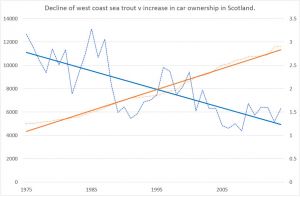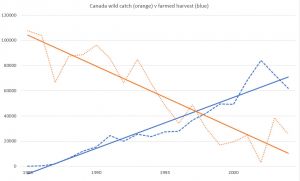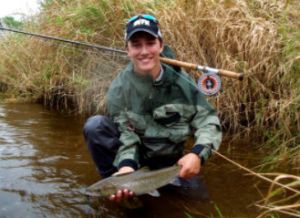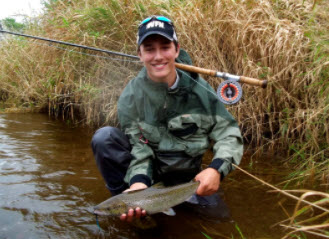The whole story: The last issue of reLAKSation included a graph showing a correlation between a decline in west coast wild salmonids and increased car ownership in Scotland.

I recently came across a book entitled – ‘Salmon Farming: The Whole Story’ by Peter A Robson. The book, from 2006, details the development of the salmon farming industry in Canada. Mr Robson says that it would have been easier to write this book if he had taken a position squarely for or against salmon farming. Instead, he says that he has tried to look past the spin, hype and controversy and informing ourselves as best we can. He hopes the book is a step in the right direction.
My interest in the book is the detail about the early days of the industry from the 1970s onward although production didn’t really take off until the late 1980s. I visited Vancouver Island in the late 1980s and production then was still under 10,000 tonnes. Mr Robson includes a table in the book detailing the annual farmed harvest and the wild catch from 1981 to 2004. I have used his data to produce the following graph. It looks remarkably similar to the one above. The wild catch is in orange and farmed harvest in blue.

It’s not surprising that critics in Canada blame salmon farming for the decline in wild salmon for clearly there is a direct correlation but like the correlation between increased car ownership and declines of wild salmonids, correlation does not mean cause.
The page after the table includes the following paragraph:
“In the fall of 2000, pink salmon returns to the Broughton archipelago were the highest ever recorded: 3.6 million fish. However, few of the hundreds of millions of fry that resulted from the spawning returned to spawn two years later. Alexandra Morton attributed the low run to sea-lice from salmon farms. The provincial government disagreed, but Morton’s concerns made headlines and triggered an intensive series of government studies into sea-lice populations and interactions with farmed fish.” …. “Meanwhile, sea-lice have become a focus of opposition to the salmon farming industry.”
Of course, those of us from outside Canada have been aware of Alexandra Morton’s claims about pink salmon for many years. This is because some of the original work was highlighted by Vivian Krause as what caused her to investigate the funding of demarketing campaigns against the international salmon farming sector.
Vivian noted that in 2005, the David Suzuki Foundation warned that sea lice have commonly killed over 80% of the annual pink salmon returns and that salmon farming had caused sea lice levels to skyrocket 30,000 times higher than the natural levels.
She wrote that: “from the get-go, this sea lice research has been controversial. Scientists have noted serious flaws and deviations from the commonly accepted good practices of the scientific community; lack of adequate baseline data, cherry picking of data, inaccurate and unsubstantiated claims. In stark contrast the David Suzuki Foundation described this sea lice research as undeniable, compelling, irrefutable and ‘proof’.”
I have previously discussed that Vivian has highlighted that the research failed to measure sea lice levels at any farm and that the farm referred to in the research was actually empty of fish during some of the time that the research was undertaken. What is more relevant here is that she points out that when the lead author Martin Krkosek testified at a public hearing, he admitted that his findings were ‘all correlative’ and that correlation does not show causality. She adds that when the University of Alberta publicised the research, the headline was ‘Wild salmon mortality caused by fish farms.’ Vivian says that this press release generated over 500 news stories which has led to one of the longest running and fiercest environmental controversies in BC even though the central claim that was made is false.
It is interesting that there is this willingness to believe that just because there is a correlation, then there is a connection. Martin Krkosek told the public hearing that his work was correlative. His 2005 paper also states that others have found similar correlations. In his discussion, he states that:
“Declines of wild salmonid populations correlated with sea lice infestations and salmon farms in Canada (PFRCC 2002; Morton & Williams 2004; Morton et al. 2004) and Europe (McVicar 1997, 2004) demand a cautionary approach to continued industrial expansion.
Yet, when these references are consulted, there is absolutely no suggestion of any such correlation let alone causality. The first reference is from PFRCC, which is the Pacific Fisheries Resource Conservation Council. Their 2002 report states:
“While scientific certainty is not absolute, European research does indicate that sea lice abundance can be associated with salmon farming. Given this evidence, combined with the presence of sea lice on Broughton Archipelago pink salmon smolts, and the fact the decline in numbers was limited to Broughton Archipelago fish, the Council believes that sea lice were associated with the decline observed in the Broughton Archipelago.”
There is no mention of any correlation simply an assumption based on circumstantial evidence and this evidence is provided to the PFRCC by none other than Alexandra Morton.
The 2004 paper by Alexandra Morton and R. Williams is published in a lesser-known Canadian journal (Can Fld Nat) and is not readily available in the UK but its title beginning ‘first report’ does not suggest any deeper knowledge than provided in her second paper of the same year. This second Morton paper suggests that sea lice were more abundant on wild fish near farms but makes no mention of any correlation or of any declines.
Martin Krkosek also refers to work from Europe with two papers from Alistair McVicar. The earlier paper states that:
“It is likely that the lice population and other diseases in farms contribute infection to local wild stocks, but the extent and consequences of this have not been quantified.”
His later paper states that:
“The large array of factors that cause variations in both the size of fish stocks and the level of fish diseases is frequently overlooked.”
The reality is that none of the papers cited by Martin Krkosek actually support his claims about a correlation between declines of wild salmon population and sea lice infestations. Alistair McVicar states that
“Although correlation has been found between some data sets, a series of international meetings of experts has not been able to establish cause–effect relationships between lice on farms and the current low level of salmonid stocks in Europe and eastern Canada.” He adds that research is currently in progress in Western Canada. That was in 2004. Sixteen years on, there is still no proof of a causative link.
Protected: The Guysborough Journal reports that the Canadian federal government plans to list Atlantic salmon as a protected ‘Species at Risk’. Yet, surprisingly, and ironically, local ‘conservation’ groups opposed the listing. The paper says that a board member from the St Mary’s River Association (SMRA) has said that the listing will hinder their existing efforts to protect the fish. The members said that when the species is listed, there is a general prohibition against harming or harassing that species. This could impact critical research, recovery, and restoration efforts.
SMRA continue that ‘Conservation is a human activity and Atlantic salmon need people who care. Our group is concerned that our work and that of others will be negatively impacted. We should not be alienated from the rivers and the aquatic species we care about and a ‘Species at Risk’ (SARA) listing could do just that.
The newspaper says that SMRA is not alone. The Nova Scotia Salmon Association (NSSA) and the Atlantic Salmon Federation (ASF) have expressed grave reservation about the federal government’s plans. NSSA recently posted on their website that SARA triggers legal prohibitions which would effectively end recreational angling. The ASF say that a SARA listing would close low impact fisheries on more than 130 rivers in Eastern Canada. It would also prevent the reopening of some rivers in Nova Scotia and New Brunswick They add that this is unnecessary and ill-timed.
Instead, NSSA say that a well-managed catch and release fishery fosters stronger public engagement in salmon conservation as well as providing important stock size data and helping to prevent poaching due to the presence of responsible anglers.
It’s not surprising that these ‘angling’ groups are opposed to more stringent protection for Atlantic salmon because when it comes to salmon fisheries, conservation means conserving more salmon for anglers to catch.
However, I wonder if the ‘cost’ of allowing ‘responsible’ catch and release with its potential mortality rate of up to 20% may exceed the possible loss of fish to poaching that might result as a consequence of banning ‘responsible’ angling. In addition, many fisheries organisations are set up as charities and will still be able to raise money to employ security teams to prevent poaching of this iconic fish. After all, poaching usually occurs at night, long after ‘responsible’ anglers are safely tucked up in their beds.
The big question for the Canadian federal government is whether conservation is about protecting Atlantic salmon or protecting angling for salmon.
 From SMRA website.
From SMRA website.
Blinkered: The Times newspaper reports that British shellfish producers have been told that they face a permanent ban on selling oysters, mussels, and scallops to the Continent because they no longer comply with European food safety rules. The EU has strict rules for imports from third countries which is what the UK now is. The issue revolves around purification of live bivalves which was always conducted in the EU because such purification cuts down on the shelf life of the shellfish. Initially, it was thought the ban might be lifted later this year, but the EU have now made it clear that the ban will be now made permanent. The Department for the Environment, Food & Rural Affairs (DEFRA) said that they are trying to seek a solution to allow trade to continue.
Of course, all this was entirely predictable after the UK voted to leave the EU and the single market so no-one should be surprised. Of even less surprise is the lack of recognition to address the issues before they became an issue.
A couple of years ago, DEFRA announced a new £10 million fund to support innovation in the fisheries and aquaculture sector. Unfortunately, those running the fund weren’t innovative enough to recognise that the step-change they wanted to see needed to focus the innovation on more than technology but also on new ways to tackle the markets simply because if there is no market, then any production related technology is irrelevant.
So, whilst fishing boats remain tied up because European markets are much harder to access and the UK public don’t want to eat what fish they catch, and some shellfish producers are permanently excluded from Europe, we should all rejoice that DEFRA are funding a project to introduce full traceability for marine ingredients and another to assess electric outboards for small fishing vessels.
The issue of market development in relation to the Seafood Innovation Fund was put to DEFRA for consideration but because innovative market development wasn’t included in the original concept, it is not included in the current remit. I even discussed the issue with DEFRA at their office in London, but it seems there is a lack of innovative thinking to promote the necessary innovation to help the fisheries sector overcome its current market problems.
Abuse: Devi Sridhar, Professor of Global Health at the University of Edinburgh recently tweeted the following:

It is a sad world we live in when someone has to tweet such a message but sadly it is all too true. Unfortunately, this is what can only be described as the way it is with those following whatever cause they follow, who prefer personal attacks to engaging in discussion of the issues. The aquaculture sector is no different with a group of mainly sad older men predominating who prefer to use abusive language and personal attacks in a belief that it promotes their cause. However, they fail to recognise that they have alienated those who they are trying to influence.
I believe that reference was recently made about one industry critic who has apparently tweeted over four thousand tweets in the past years. Despite his efforts not one single one of those tweets has contributed to the discussion.
When these critics stand up and are willing to express and debate their concerns in their own name then perhaps someone might be willing to listen but until then they are simply blowing in the wind.
Even sadder still, are the attacks on those working in salmon farming in Canada who are willing to stand up for their industry and who just also happen to be female. This is just so totally unacceptable but sadly what we have come to expect from those who prefer to hide behind their PC screens.

